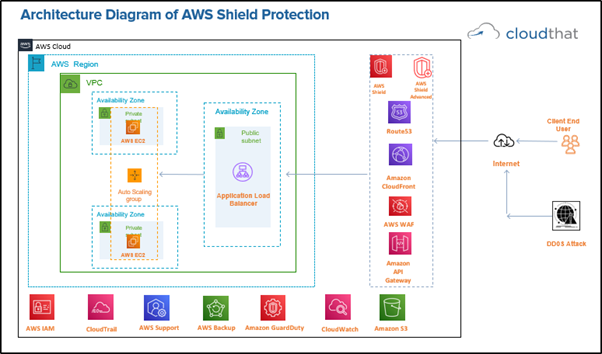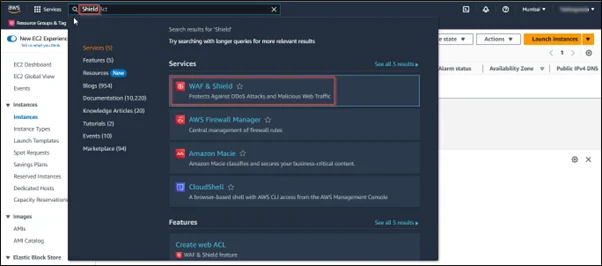|
Voiced by Amazon Polly |
Overview
In today’s digital landscape, the availability and security of online services are paramount. Distributed Denial of Service (DDoS) attacks continue to pose a significant threat to organizations, potentially causing downtime, financial losses, and reputational damage. Amazon Web Services (AWS) offers a robust solution called AWS Shield to combat these challenges. In this blog, we’ll delve into the world of DDoS protection and explore how AWS Shield can empower businesses to boost availability and effectively manage DDoS attacks.
Pioneers in Cloud Consulting & Migration Services
- Reduced infrastructural costs
- Accelerated application deployment
Introduction
DDoS attacks involve overwhelming a target system or network with a flood of traffic, rendering it inaccessible to legitimate users. Attackers often deploy botnets – networks of compromised computers – to orchestrate these attacks. The impact can be devastating, disrupting services, damaging customer trust, and incurring substantial financial losses.
The Need for DDoS Protection
Maintaining continuous availability is crucial as businesses rely heavily on their online presence. A successful DDoS attack can disrupt operations, lead to lost revenue, and even harm an organization’s brand image. Traditional security measures like firewalls and intrusion detection systems are insufficient to mitigate the scale and sophistication of modern DDoS attacks. This is where AWS Shield comes into play.
AWS Shield
AWS Shield is a managed Distributed Denial of Service (DDoS) protection service designed to safeguard applications running on AWS. It offers two tiers – Standard and Advanced – tailored to various needs and complexities. Let’s take a closer look at each tier:
- AWS Shield Standard (Free Service):
- Automatically included at no extra cost with most AWS services.
- Protects against most common, well-known network and transport layer DDoS attacks.
- Provides always-on detection and automatic inline mitigations to minimize downtime and latency.
- AWS Shield Advanced (Paid Service):
- Offers enhanced protection against larger and more sophisticated DDoS attacks.
- Real-time attack visibility and detailed metrics empower organizations to fine-tune their security strategies.
- Access to the AWS Global Threat Environment dashboard for actionable insights.
- 24/7 access to the AWS DDoS Response Team (DRT) for personalized support during attacks.
- Mitigation of application-layer attacks that may impact the performance of your applications.
Boosting Availability with AWS Shield
- Rapid and Automatic DDoS Mitigation – AWS Shield provides automatic mitigation against DDoS attacks, ensuring minimal disruption to your services. With its always-on detection and mitigation capabilities, your applications remain available even during attack instances.
- Scalable Architecture – AWS Shield is designed to scale with your application’s needs. Whether you’re running a small website or a complex multi-tier application, AWS Shield can adapt to handle traffic spikes and evolving attack vectors.
- Protection Against Different Attack Vectors – From volumetric attacks that flood your network bandwidth to sophisticated application-layer attacks targeting your application’s resources, AWS Shield defends against a wide range of attack vectors.
- Customizable Protection – AWS Shield allows you to fine-tune your DDoS protection strategy by adjusting settings and thresholds according to your application’s requirements. This flexibility ensures that legitimate traffic continues to flow while malicious traffic is filtered out.
Managing DDoS Attacks with AWS Shield
- Real-time Attack Visibility – AWS Shield Advanced provides a comprehensive view of ongoing attacks through the Global Threat Environment dashboard. This real-time visibility empowers you to make informed decisions during an attack.
- Actionable Insights – With access to attack metrics and patterns, you can analyze historical data to understand your application’s threat landscape better. This knowledge helps you bolster your defenses and refine your incident response plan.
- 24/7 Support – In the face of a DDoS attack, timely response is crucial. AWS Shield Advanced offers around-the-clock AWS DDoS Response Team access, ensuring expert assistance during critical moments.
Working of AWS Shield
AWS Shield Standard and AWS Shield Advanced protect against DDoS attacks at both the network and transport layers and the application layer for your resources.
Moreover, if you use services such as Amazon CloudFront, Amazon Route 53, and Amazon Elastic Load Balancer, AWS Shield automatically extends protection to your resources at no additional cost.
Organizations can create customized web access control lists (web ACLs) with traffic inspection conditions translated into rules. Each rule can trigger an action, which can be either allowing, blocking, or counting traffic.
The “count” mode proves valuable for organizations as it allows them to monitor traffic patterns and make informed decisions about whether to implement a particular rule in “allow” or “block” mode.
One clear illustration of this capability is the rate-limiting feature, where it is automatically blocked if an IP address exceeds 2,000 requests within a five-minute interval.

AWS Shield Pricing
These charges are separate from the standard fees for Amazon CloudFront, Amazon Route 53, Amazon Elastic Compute Cloud (EC2), and Global Accelerator services.

Data Transfer out Fees

Steps to set up AWS Sheild
Step 1: Log in to your AWS Console and navigate to the ‘AWS Shield’ service.

Step 2: Within the AWS WAF & Shield panel, navigate to ‘Getting started’ on the left-hand side, and on the right-hand side, select ‘Subscribe to Shield Advanced.’

Step 3: To subscribe to AWS Shield Advanced, you must accept all the terms and conditions. Check all the checkboxes to continue, then click the ‘Subscribe’ button.

Step 4: Congratulations! You have now successfully subscribed to advanced protection. You can proceed to the next step, ‘Adding resources to protect.’

Step 5: Click ‘Add resources for protection’ to begin adding your resources.

Step 6: In this section, select your preferred region and the type of resources you wish to protect. You can also click “Load more resources” to include additional resources.

Conclusion
By leveraging AWS Shield, organizations can confidently navigate the ever-evolving threat landscape and provide their users with a seamless and secure experience.
Drop a query if you have any questions regarding AWS Shield and we will get back to you quickly.
Making IT Networks Enterprise-ready – Cloud Management Services
- Accelerated cloud migration
- End-to-end view of the cloud environment
About CloudThat
CloudThat is an official AWS (Amazon Web Services) Advanced Consulting Partner and Training partner, AWS Migration Partner, AWS Data and Analytics Partner, AWS DevOps Competency Partner, Amazon QuickSight Service Delivery Partner, AWS EKS Service Delivery Partner, and Microsoft Gold Partner, helping people develop knowledge of the cloud and help their businesses aim for higher goals using best-in-industry cloud computing practices and expertise. We are on a mission to build a robust cloud computing ecosystem by disseminating knowledge on technological intricacies within the cloud space. Our blogs, webinars, case studies, and white papers enable all the stakeholders in the cloud computing sphere.
To get started, go through our Consultancy page and Managed Services Package, CloudThat’s offerings.
FAQs
1. What are the benefits of upgrading to AWS Shield Advanced?
ANS: – AWS Shield Advanced offers enhanced DDoS protection, AWS DDoS Response Team (DRT) access, and advanced threat intelligence, making it suitable for high-profile applications with higher security needs.
2. Is AWS WAF included with AWS Shield, and how does it complement DDoS protection?
ANS: – AWS WAF is a separate service but can work in conjunction with AWS Shield. It helps protect against application layer (Layer 7) attacks and allows you to create rules for filtering and blocking traffic.
3. How can I monitor DDoS attacks and traffic patterns with AWS Shield?
ANS: – You can use AWS CloudWatch alarms to monitor key metrics related to DDoS attack detection and traffic. Additionally, AWS Shield Advanced provides detailed attack visibility.

WRITTEN BY H S Yashas Gowda
Yashas Gowda works as a Research Associate at CloudThat. He has good hands-on experience working on Azure and AWS services. He is interested to learn new technologies and tries to implement them.


 Login
Login


 September 20, 2023
September 20, 2023 PREV
PREV








Comments